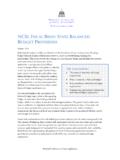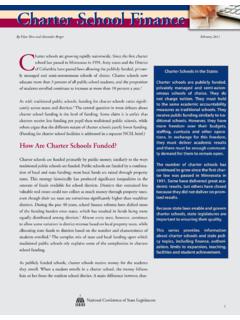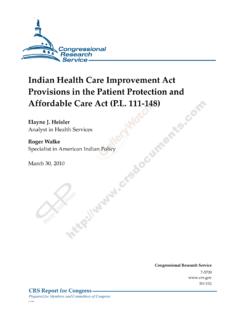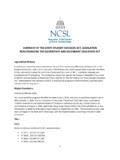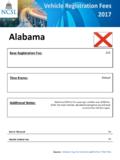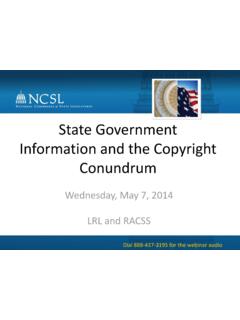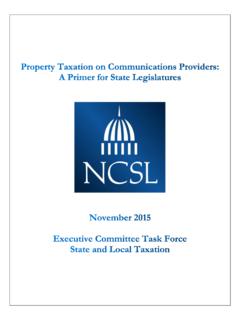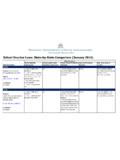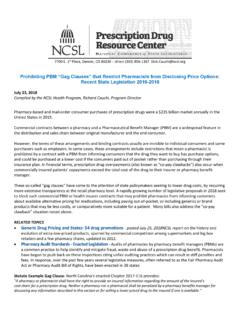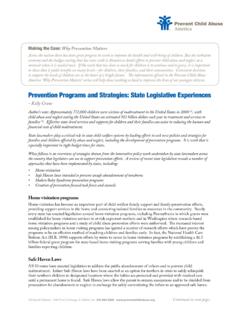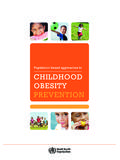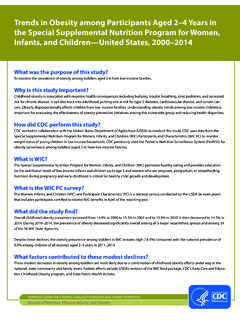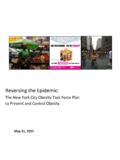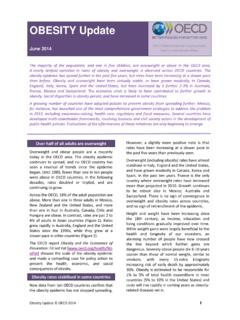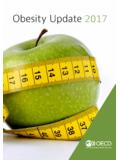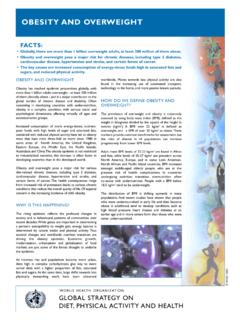Transcription of State Actions to Reduce and Prevent Childhood Obesity in ...
1 National Conference of State Legislatures l 1 State Actions to Reduce and Prevent Childhood Obesity in Schools and CommunitiesState Actions to Reduce and Prevent Childhood Obesity in Schools and Communities Summary and Analysis of Trends in LegislationState Actions to Reduce and Prevent Childhood Obesity in SchoolS and communitieS SummaRy and analySiS of tRendS in legiSlationByAmy WinterfeldNational Conference of State LegislaturesWilliam T. Pound, Executive Director7700 East First PlaceDenver, Colorado 80230(303) 364-7700444 North Capitol Street, , Suite 515 Washington, 20001(202) 2014 The National Conference of State Legislatures is the bipartisan organization that serves the legislators and staffs of the states, commonwealths and territories. NCSL provides research, technical assistance and opportunities for policymakers to exchange ideas on the most pressing State issues and is an effective and respected advocate for the interests of the states in the American federal system.
2 Its objectives are: To improve the quality and effectiveness of State legislatures. To promote policy innovation and communication among State legislatures. To ensure State legislatures a strong, cohesive voice in the federal Conference operates from offices in Denver, Colo., and Washington, for this report was provided by a grant from the Kellogg Foundation as part of its Food & Community national program. 2014 by the National Conference of State Legislatures. All rights reserved. ISBN 978-1-58024-714-6 The author would like to acknowledge the contributions of Larry Morandi, Douglas Shinkle, Leann Stelzer and Alise Conference of State Legislatures l iiiState Actions to Reduce and Prevent Childhood Obesity in Schools and CommunitiesContentsIntroductIon ..1 FIndIngs ..3 LegIsLatIon summarIes ..10 School-Focused Policies for Healthy Eating and Physical Activity School Nutrition.
3 10 Nutrition Education ..17 Farm-to-School ..17 Body Mass Index Measurement or Student Fitness Screening at School ..20 Diabetes Screening and Management at School ..21 Joint or Shared Use Agreements for School Facilities ..23 Physical Activity or Physical Education in School and School Recess ..24 Preschool Obesity Prevention ..28 School Wellness Policies ..29 Community or Statewide Policies for Healthy Eating and Physical Activity Access to Healthy Foods ..30 Community Physical Activity through Bicycling and Walking/Complete Streets ..32 Farmers Markets/Local Food Marketing/Sustainable Food Systems ..36 Raising Awareness ..41 Task Forces, Commissions, Studies, Grants and Other Special Programs ..42 Taxes, Tax Credits, Tax Exemptions and Other Fiscal Incentives ..46 Urban Agriculture/Community Gardens ..47notes ..48 LIst oF FIgures and tabLesFigures 1.
4 State Legislation, All Categories, 2012-2013 ..42. School-Focused Legislation for Healthy Eating and Physical Activity, 2012-2013 ..53. Community & State -Focused Legislation for Healthy Eating and Physical Activity, 2012-2013 ..5 Tables1. School-Focused Healthy Eating and Physical Activity Legislation, 2012-2013 ..62. Community & State -Focused Legislation for Healthy Eating and Physical Activity, 2012-2013 ..8 National Conference of State Legislatures l 1 State Actions to Reduce and Prevent Childhood Obesity in Schools and CommunitiesIntroduCtIonAccording to the Centers for Disease Control and Prevention, Childhood Obesity has more than doubled in children and quadrupled in adolescents in the past 30 From 1980 to 2012, the percentage of children ages 6 to 11 in the United States who were obese increased from 7 percent to nearly 18 percent.
5 Among youth ages 12 to 19, Obesity increased from 5 percent of adolescents in 1980 to almost 21 percent in Although some progress in reducing Childhood Obesity has recently been reported for very young chil-dren,3 in total, by 2012, more than one-third of American children and adolescents were either overweight or Obesity prevalence continues to be high and obese children and youth are likely to become obese adults,5 Childhood Obesity remains a pressing public health concern. Immediate health effects for obese children include development of risk factors for cardiovascular disease, such as high cholesterol or high blood pres-sure 70 percent of obese 5- to 17-year-olds in one population-based sample had at least one risk factor for cardiovascular disease;6 a greater likelihood of prediabetes, and higher risk for bone and joint problems, sleep apnea, and social and psychological problems such as stigmatization and poor Over the long-term, these health effects put obese children on a trajectory for costly and debilitating adult health problems such as heart disease, type 2 diabetes, stroke, a number of cancers and Healthy lifestyle habits, such as nutritious eating and a physically active lifestyle, can help to Prevent or Reduce Obesity and the risk for associated health Policymakers in many states have stepped up to create choices for healthy eating and active living in schools, child care facilities and communities where children and their families live.
6 For children, who spend a large portion of their waking hours in school, the school environ-ment can be crucial in supporting healthy behaviors by providing healthy food choices and opportunities to be physically active during the school day. This report summarizes legislation and presents policy options for legislators interested in reducing and preventing Childhood Obesity in schools and legislation summarized and categorized in this report was enacted during the 2012-2013 State legislative sessions. During these years, State lawmakers continued to show sustained interest in policy strategies and op-tions to support school and community environments that provide healthy food and physical activity choices to Reduce or Prevent Childhood Obesity . Policy trends in this arena were described in four earlier NCSL reports covering State legislation from 2007 through 2011: Promoting Healthy Communities and Reducing Childhood Obesity : Legislative Options;10 Promoting Healthy Communities and Preventing Childhood Obesity : Trends in Recent Legislation;11 Reversing the Trend in Childhood Obesity : Policies to Promote Healthy Kids and Communities,12 and State Actions to Promote Healthy Communities and Prevent Childhood Obesity : Summary and Analysis of Trends in Policy analysis and research evidence presented in this report updates information contained in the previous reports as related to trends in State legislation enacted during the 2012-2013 sessions.
7 National Conference of State Legislatures l 2 State Actions to Reduce and Prevent Childhood Obesity in Schools and CommunitiesRePoRt oRganizationEnacted State legislation summarized in this report covers the broad policy categories of healthy eating and physical activity in school and community settings that provide opportunities to choose nutritious foods and safe places to play and exercise. Policies are grouped into two general rubrics, school-focused policies and com-munity or statewide policies for healthy food and physical activity. In each rubric, policies are reported in these specific topic areas: School-Focused Policies for Healthy Eating and Physical Activity School Nutrition Nutrition Education Farm to School Body Mass Index Measurement or Student Fitness Screening at School Diabetes Screening and Management at School Joint or Shared Use Agreements for School Facilities Physical Activity or Physical Education in School and School Recess Preschool Obesity Prevention School Wellness PoliciesCommunity or Statewide Policies for Healthy Eating and Physical Activity.
8 Access to Healthy Foods Community Physical Activity through Bicycling and Walking/Complete Streets Farmers Markets/Local Food Marketing/Sustainable Food Systems Raising Awareness Task Forces, Commissions, Studies, Grants and Other Special Programs Taxes, Tax Credits, Tax Exemptions and Other Fiscal Incentives Urban Agriculture/Community Gardens Some bills may fall into more than one category for example, school nutrition policies that also relate to school wellness efforts, or tax credits that provide incentives for businesses to develop retail access to healthy food. As a result, enacted legislation may be summarized in more than one category with the provisions most relevant to each category highlighted in the bill summary for that category. Proposed legislation that has not been enacted also may be referenced in the narrative description of each category to illustrate trends in legisla-tion that may serve as precursors to laws enacted in subsequent sessions.
9 Also summarized are bills considered in 2013 that remained pending in legislatures that had not yet adjourned their 2013-2014 legislative sessions as of May 2014 or that may carry over to the 2014 sessions. National Conference of State Legislatures l 3 State Actions to Reduce and Prevent Childhood Obesity in Schools and CommunitiesFIndIngs State legislation designed to promote healthy eating and active living, especially among school-age children, continued to draw interest from policymakers in 2012-2013. This report covers two years of State legislative Actions during which 46 states and the District of Columbia enacted laws related to healthy food and physical activity in schools or designed to provide community-wide or statewide policy for healthy eating and physically active lifestyles. In addition two broad-based bills to address Obesity challenges remain pending in Puerto Rico.
10 In the broad policy category of school-focused policies for healthy eating and physical activity, most of the legislative activity was in two areas: 1) school nutrition and nutrition education, and 2) physical activity and physical education. Thirty-one states and the District of Columbia enacted legislation related to school nutri-tion, including bills focused on nutrition education, during 2012-2013; while at least nine additional states enacted farm to school legislation. Ten states enacted legislation on physical activity or physical education in schools in 2012-2013. In the broad policy category of community or statewide policies for healthy food and physical activity 37 states and the District of Columbia enacted laws during 2012-2013. Legislative interest continued in the areas of bicycling and walking/complete streets, and farmers markets/local food marketing, topics with high levels of activity in past years.
